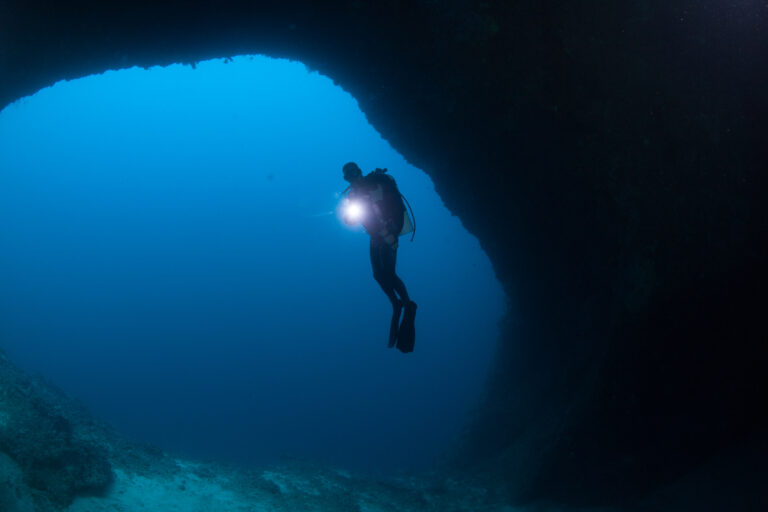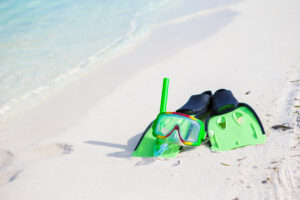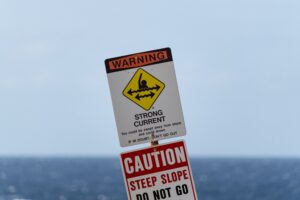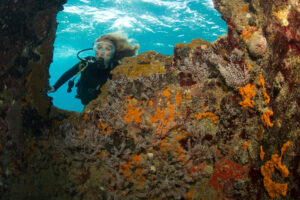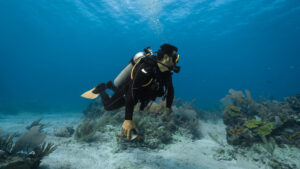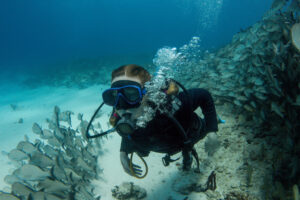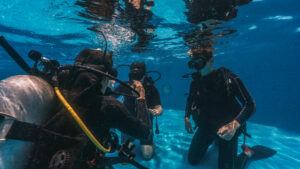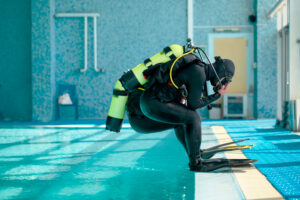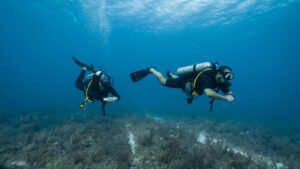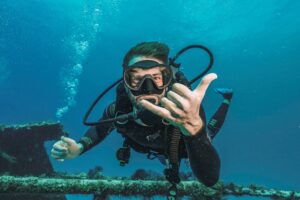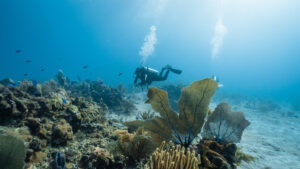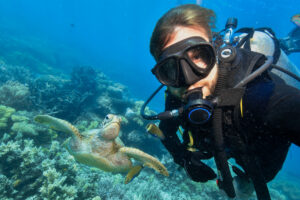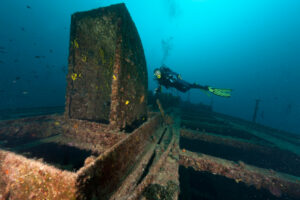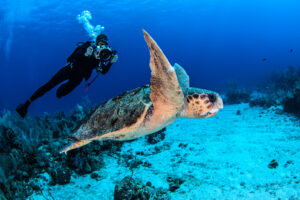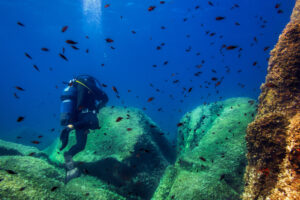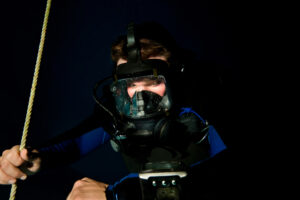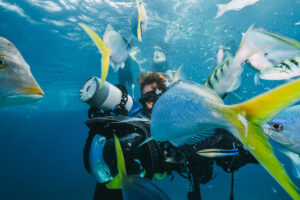What is a Kelp Surface Dive?
A kelp surface dive involves swimming and exploring near the surface of the ocean where dense forests of kelp thrive. This activity is popular among divers and marine enthusiasts for its unique opportunity to observe a vibrant and ecologically significant environment. Kelp forests are found in coastal areas worldwide and are known for their towering, underwater canopies. These dives offer an unparalleled chance to witness marine life that thrives within these underwater forests while requiring less equipment and technical expertise than deeper dives. Kelp surface diving is both a recreational pursuit and a valuable method for scientists studying these critical ecosystems.
Understanding Kelp Forests
Kelp forests are underwater areas with a high density of kelp, which are large brown algae belonging to the order Laminariales. These forests are most commonly found along the coastlines of the Pacific Ocean, particularly off the coasts of California, South Africa, Australia, and Chile. Kelp can grow rapidly, up to 60 cm (24 inches) per day in ideal conditions, and can reach lengths of over 45 meters (147 feet). The primary species forming these forests include giant kelp (Macrocystis pyrifera) and bull kelp (Nereocystis luetkeana).
These underwater forests play a crucial role in marine ecosystems. They provide habitat, food, and protection for many marine species, from invertebrates to large fish and mammals. Kelp forests also help protect coastlines from erosion by dissipating wave energy and stabilizing sediment. Moreover, they contribute significantly to the ocean’s productivity by supporting a diverse range of life forms and enhancing the overall biodiversity of the areas they inhabit.
The ecological importance of kelp forests cannot be overstated. They act as carbon sinks, absorbing CO2 from the atmosphere, which helps mitigate the impacts of climate change. Additionally, kelp forests are vital for commercial fisheries, offering breeding and feeding grounds for numerous fish species. This makes their preservation essential not only for maintaining biodiversity but also for supporting human industries dependent on healthy marine environments.
Basics of Surface Diving
Surface diving, often referred to as skin diving, involves swimming on or near the surface of the water with the aid of snorkeling gear. Unlike scuba diving, which requires specialized equipment and training for deep-water exploration, surface diving is more accessible and can be enjoyed by a wider range of people. Basic gear includes a mask, snorkel, and fins. A wetsuit may also be worn to provide thermal protection and buoyancy.
Surface diving allows individuals to observe underwater environments without the need for complex breathing apparatus. Divers typically use a technique called “duck diving” to submerge briefly, allowing for closer inspection of underwater features or marine life before returning to the surface to breathe. This method relies on breath-holding and does not involve the use of compressed air tanks.
One of the key aspects that differentiate surface diving from other forms of underwater exploration is its accessibility. Because it requires minimal equipment and training, it is an ideal activity for beginners and those looking to enjoy the beauty of underwater environments without the technical challenges associated with scuba diving. It also allows for greater mobility and freedom of movement, making it easier to navigate through dense kelp forests.
Preparation for Kelp Surface Diving
Preparation for a successful kelp surface dive involves several important steps to ensure both safety and enjoyment. Physical fitness and swimming proficiency are essential, as the diver will need to navigate through potentially strong currents and dense vegetation. Basic skills such as breath control, buoyancy management, and efficient finning techniques are crucial for maneuvering in the kelp forest.
Selecting the appropriate equipment is also key. A high-quality mask with a good seal will prevent water from entering and ensure clear vision. The snorkel should be comfortable and allow for easy breathing at the surface, while fins should be chosen for their efficiency and comfort. In colder waters, a wetsuit is necessary to provide insulation and buoyancy, keeping the diver warm and reducing the risk of hypothermia.
Safety checks and communication strategies are vital components of the preparation process. Divers should always check their gear for functionality before entering the water, ensuring that masks, snorkels, and fins are in good working condition. It is also important to familiarize oneself with the dive site, understanding the specific hazards and conditions that might be encountered. Communication signals should be established with dive buddies to maintain contact and ensure mutual safety throughout the dive.
Environmental awareness is another critical aspect of preparation. Divers should strive to minimize their impact on the kelp forest, avoiding physical contact with the plants and marine life. Understanding the local marine regulations and guidelines helps protect these fragile ecosystems and ensures that the activity remains sustainable for future generations.
Techniques in Kelp Surface Diving
Mastering the techniques involved in kelp surface diving enhances the experience and ensures safety. Entering a kelp forest requires a gentle approach to avoid damaging the delicate plants. Divers should swim slowly and steadily, using their arms as little as possible to minimize disturbance. Fins should be used for propulsion, with smooth and controlled movements to navigate through the kelp.
Navigating within the kelp forest can be challenging due to the dense and often entangled vegetation. Divers should remain horizontal and streamlined, keeping their bodies close to the surface to reduce the risk of entanglement. If a diver does become entangled, it is important to remain calm and methodically free oneself without making sudden movements. Cutting tools, such as a small knife or shears, can be carried for emergency situations but should be used as a last resort.
Observing marine life within the kelp forest is one of the highlights of surface diving in these environments. Divers can encounter a variety of species, including fish, invertebrates, and marine mammals. Patience and stillness are key to getting close to wildlife; sudden movements can scare animals away. Using a camera with underwater capabilities allows divers to capture the beauty of the kelp forest and its inhabitants without physically interacting with them.
Buoyancy control is another essential technique for kelp surface diving. Divers must manage their buoyancy to stay at the desired depth, which often involves adjusting their breath control and body position. Proper use of a wetsuit and weights can help maintain neutral buoyancy, allowing for effortless gliding through the water.
Challenges and Hazards
Kelp surface diving presents unique challenges and hazards that require careful consideration and preparation. One of the primary risks is entanglement in the kelp itself. The long, trailing fronds can easily wrap around a diver’s body or equipment, making it difficult to move. Staying calm and using slow, deliberate movements is essential to free oneself from entanglement. Regularly practicing disentanglement techniques can also help divers react appropriately if they encounter this situation.
Reduced visibility is another common challenge in kelp forests. The dense canopy of kelp can block out sunlight, creating darker conditions underwater. Silt and debris stirred up by currents or other divers can further reduce visibility. Divers should stay close to their buddies and use hand signals or other agreed-upon methods to maintain communication in low-visibility conditions.
Strong currents are often present in kelp forest environments, posing a significant hazard for surface divers. These currents can quickly tire a diver or push them into hazardous areas. Understanding the local tidal patterns and planning dives during slack tide, when currents are weaker, can help mitigate this risk. Divers should also be aware of their surroundings and avoid areas where strong currents are known to be prevalent.
Marine life interactions, while often a highlight, can also pose risks. Some species within kelp forests, such as sea urchins or jellyfish, can cause injury if handled or accidentally contacted. Divers should maintain a respectful distance from all marine life and be aware of potentially harmful species. Wearing protective clothing, such as gloves and wetsuits, can provide an additional layer of safety.
Environmental conditions such as cold water temperatures can also present challenges. Prolonged exposure to cold water can lead to hypothermia, even with a wetsuit. Divers should monitor their body temperature and exit the water if they start to feel excessively cold. Hydration and proper nutrition before and after the dive can also help maintain body warmth and energy levels.
Benefits and Significance of Kelp Surface Diving
Kelp surface diving offers numerous benefits and holds significant importance both for individuals and the broader marine ecosystem. Ecologically, kelp forests are among the most productive and dynamic ecosystems in the ocean. They provide critical habitat and food sources for a wide range of marine species, from tiny invertebrates to large marine mammals. By engaging in kelp surface diving, individuals can directly observe and appreciate these vibrant ecosystems, fostering a deeper understanding and respect for marine biodiversity.
For divers, the experience of kelp surface diving is uniquely rewarding. It offers a chance to immerse oneself in a serene and otherworldly environment, surrounded by towering kelp fronds and diverse marine life. The activity can be a form of underwater meditation, allowing divers to connect with nature in a profound way. The visual spectacle of sunlight filtering through the kelp canopy, combined with the rich variety of colors and shapes of marine organisms, creates a truly mesmerizing experience.
Kelp surface diving also plays a role in marine conservation efforts. Divers often become advocates for the protection of these vital ecosystems, contributing to conservation initiatives and supporting sustainable practices. Through citizen science programs, divers can assist in monitoring the health of kelp forests, collecting data on species populations, and documenting changes in the environment. This grassroots involvement is crucial for the long-term preservation of kelp forests and the overall health of the ocean.
The activity is accessible to a wide range of people, from beginners to experienced divers, making it an inclusive and versatile pursuit. It requires minimal equipment and training, allowing more people to participate and appreciate the underwater world. By providing an entry point into the world of marine exploration, kelp surface diving can inspire a lifelong passion for the ocean and its conservation.
Key Takeaways
Kelp surface diving offers a unique and accessible way to experience the beauty and importance of kelp forests. These underwater environments are vital for marine biodiversity, providing habitat and food
for numerous species. Surface diving in kelp forests allows individuals to observe and appreciate this dynamic ecosystem while promoting conservation efforts. By preparing adequately and mastering essential techniques, divers can safely navigate and enjoy the wonders of kelp surface diving.

